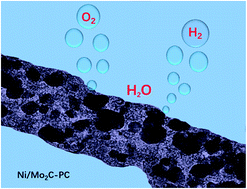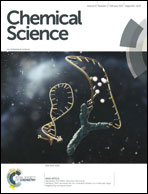A one-dimensional porous carbon-supported Ni/Mo2C dual catalyst for efficient water splitting†
Abstract
The development of active, stable and low-cost electrocatalysts towards both the hydrogen evolution reaction (HER) and oxygen evolution reaction (OER) for overall water splitting remains a big challenge. Herein, we report a new porous carbon-supported Ni/Mo2C (Ni/Mo2C-PC) composite catalyst derived by thermal treatment of nickel molybdate nanorods coated with polydopamine, which efficiently and robustly catalyses the HER and OER with striking kinetic metrics in alkaline electrolyte. The catalyst affords low onset potentials of −60 mV for the HER and 270 mV for the OER, as well as small overpotentials of 179 mV for the HER and 368 mV for the OER at a current density of 10 mA cm−2. These results compare favorably to Mo2C-PC, Ni-PC, and most other documented Ni- and Mo-based catalysts. The high activity of Ni/Mo2C-PC is likely due to electron transfer from Ni to Mo2C, leading to a higher Ni valence and a lower Mo valence in the Ni/Mo2C-PC catalyst, as these are HER and OER active species and thus account for the enhanced activity. Remarkably, our home-made alkaline electrolyser, assembled with Ni/Mo2C-PC as a bifunctional catalyst, can enable a water-splitting current density of 10 mA cm−2 to be achieved at a low cell voltage of 1.66 V.

- This article is part of the themed collections: ISACS21: Challenges in Nanoscience and Global Energy Challenges: Electrochemical Energy


 Please wait while we load your content...
Please wait while we load your content...